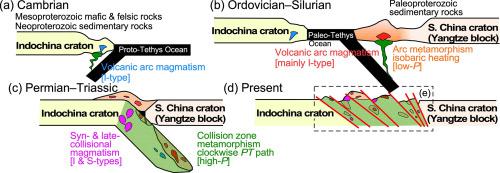当前位置:
X-MOL 学术
›
Gondwana Res.
›
论文详情
Our official English website, www.x-mol.net, welcomes your
feedback! (Note: you will need to create a separate account there.)
Evolution of the Indochina Block from its formation to amalgamation with Asia: Constraints from protoliths in the Kontum Massif, Vietnam
Gondwana Research ( IF 7.2 ) Pub Date : 2021-02-01 , DOI: 10.1016/j.gr.2020.11.002 Nobuhiko Nakano , Yasuhito Osanai , Masaaki Owada , Pham Binh , Tomokazu Hokada , Hiroshi Kaiden , Vuong T.S. Bui
Gondwana Research ( IF 7.2 ) Pub Date : 2021-02-01 , DOI: 10.1016/j.gr.2020.11.002 Nobuhiko Nakano , Yasuhito Osanai , Masaaki Owada , Pham Binh , Tomokazu Hokada , Hiroshi Kaiden , Vuong T.S. Bui

|
Abstract This study reported the U Pb ages and Hf isotopes of the zircons of Triassic and Silurian metamorphic rocks in the Kontum Massif, central Vietnam to understand the origin and evolution of the Indochina Block. The detrital zircon signature of the Triassic metasedimentary rocks corresponds to the Neoproterozoic sequence in the Indochina Block and that of the Silurian rocks corresponds to the Paleo- to Mesoproterozoic sequence in the southwestern margin of the Yangtze Block. From Triassic metaigneous rocks, we obtained three meaningful inherited ages; ~1450 Ma, 500 Ma, and 450 Ma. The Triassic metasedimentary rocks occur in close association with the Triassic felsic gneiss and mafic granulite (former eclogite) with magmatic inherited zircon ~1450 Ma and intermediate gneiss with ~500 Ma protolith age. The Hf isotopes suggest the ~1450 Ma age as the earlier or primary stage of the formation of the Indochina Block and the ~500 Ma age as the timing of its reworking, before the block subducted beneath the South China Block to form Triassic eclogite relicts. The Ordovician magmatic ages (~450 Ma) from metaigneous rocks in the Kontum Massif, combined with their volcanic arc whole-rock chemistry, Ordovician–Silurian low-pressure/high-temperature isobaric heating metamorphism, and the detrital zircon signature strongly suggest an Ordovician–Silurian continental arc in the present southwestern margin of the South China Block prior to the Triassic continental collision.
中文翻译:

印度支那地块从形成到与亚洲合并的演化:来自越南 Kontum 地块原岩的约束
摘要 本研究报告了越南中部昆仑地块三叠系和志留系变质岩锆石的 U Pb 年龄和 Hf 同位素,以了解印度支那地块的起源和演化。三叠系变沉积岩的碎屑锆石特征对应于印度支那地块的新元古代序列,志留系岩石的碎屑锆石特征对应于扬子地块西南缘的古-中元古代序列。从三叠纪变火成岩中,我们获得了三个有意义的继承时代;~1450 Ma、500 Ma 和 450 Ma。三叠纪变沉积岩与三叠纪长英质片麻岩和镁铁质麻粒岩(前榴辉岩)密切相关,岩浆继承锆石~1450 Ma,中间片麻岩~500 Ma原岩年龄。Hf 同位素表明~1450 Ma 时代是印度支那地块形成的早期或初级阶段,~500 Ma 时代是其改造的时机,之后该地块在华南地块下俯冲形成三叠纪榴辉岩遗迹。昆仑地块变质岩的奥陶纪岩浆年龄(~450 Ma),结合它们的火山弧全岩化学,奥陶纪-志留纪低压/高温等压加热变质作用和碎屑锆石特征强烈表明奥陶纪——三叠纪大陆碰撞前华南地块西南缘的志留系大陆弧。地块俯冲到华南地块下方形成三叠纪榴辉岩遗迹之前。昆仑地块变质岩的奥陶纪岩浆年龄(~450 Ma),结合它们的火山弧全岩化学,奥陶纪-志留纪低压/高温等压加热变质作用和碎屑锆石特征强烈表明奥陶纪——三叠纪大陆碰撞前华南地块现今西南缘的志留系大陆弧。地块俯冲到华南地块下方形成三叠纪榴辉岩遗迹之前。昆仑地块变质岩的奥陶纪岩浆年龄(~450 Ma),结合它们的火山弧全岩化学,奥陶纪-志留纪低压/高温等压加热变质作用和碎屑锆石特征强烈表明奥陶纪——三叠纪大陆碰撞前华南地块现今西南缘的志留系大陆弧。
更新日期:2021-02-01
中文翻译:

印度支那地块从形成到与亚洲合并的演化:来自越南 Kontum 地块原岩的约束
摘要 本研究报告了越南中部昆仑地块三叠系和志留系变质岩锆石的 U Pb 年龄和 Hf 同位素,以了解印度支那地块的起源和演化。三叠系变沉积岩的碎屑锆石特征对应于印度支那地块的新元古代序列,志留系岩石的碎屑锆石特征对应于扬子地块西南缘的古-中元古代序列。从三叠纪变火成岩中,我们获得了三个有意义的继承时代;~1450 Ma、500 Ma 和 450 Ma。三叠纪变沉积岩与三叠纪长英质片麻岩和镁铁质麻粒岩(前榴辉岩)密切相关,岩浆继承锆石~1450 Ma,中间片麻岩~500 Ma原岩年龄。Hf 同位素表明~1450 Ma 时代是印度支那地块形成的早期或初级阶段,~500 Ma 时代是其改造的时机,之后该地块在华南地块下俯冲形成三叠纪榴辉岩遗迹。昆仑地块变质岩的奥陶纪岩浆年龄(~450 Ma),结合它们的火山弧全岩化学,奥陶纪-志留纪低压/高温等压加热变质作用和碎屑锆石特征强烈表明奥陶纪——三叠纪大陆碰撞前华南地块西南缘的志留系大陆弧。地块俯冲到华南地块下方形成三叠纪榴辉岩遗迹之前。昆仑地块变质岩的奥陶纪岩浆年龄(~450 Ma),结合它们的火山弧全岩化学,奥陶纪-志留纪低压/高温等压加热变质作用和碎屑锆石特征强烈表明奥陶纪——三叠纪大陆碰撞前华南地块现今西南缘的志留系大陆弧。地块俯冲到华南地块下方形成三叠纪榴辉岩遗迹之前。昆仑地块变质岩的奥陶纪岩浆年龄(~450 Ma),结合它们的火山弧全岩化学,奥陶纪-志留纪低压/高温等压加热变质作用和碎屑锆石特征强烈表明奥陶纪——三叠纪大陆碰撞前华南地块现今西南缘的志留系大陆弧。











































 京公网安备 11010802027423号
京公网安备 11010802027423号